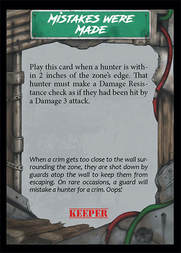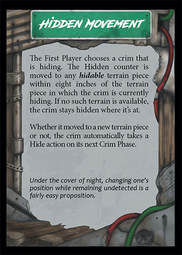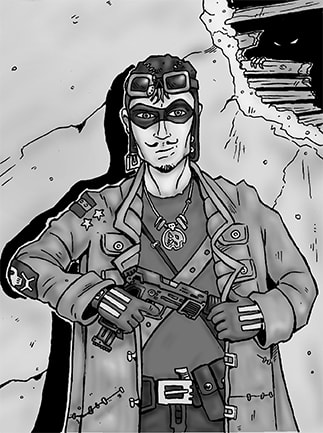While the core game will come with 15 iconic hunters for you to use straight away, one of the most eagerly anticipated aspects of Urban Manhunt is that it will allow you to create your own hunters. This means a player can utilize just about any miniature in their collection and whip up game stats for it. It also offers particularly ambitious gamers the opportunity to create elaborate conversions to fit the game stats they devise. Whichever approach one takes, Urban Manhunt will accommodate.
From a game design standpoint, creating a system that can handle the wide variety of possible miniatures was… intimidating. I knew the hunter creation rules had to be able to cover a lot of ground, which was no small feat. Realistically, not every miniature will be able to be replicated with this system. That’s just something I had to live with, as some miniatures either just aren’t compatible with the game world (e.g., a giant dragon) or have too much stuff (e.g., a miniature with half a dozen weapons). That said, you’ll have no trouble coming up with faithful stats for most humanoid miniatures.
Before I could design the hunter creation system, I had to wait until all the kinks were worked out of the core game system. Otherwise, I’d have been stuck reworking everything in the hunter creation system every time the rules of the game were changed. Fortunately, the Urban Manhunt system is intact now, despite still being in beta testing. Any changes made at this point will be minor enough that they won’t have a major impact on the hunter creation rules.
As I previously stated, diving into the hunter creation system was rather intimidating. One reason for this was that the iconic hunters had been thoroughly hashed out during playtesting and I felt the need to ensure that those hunters could be replicated with the rules. In fact, I obsessed about how to manage this, as many of the hunters’ Special Rules, Momentum Options and Attacks were so specific to them (Neon Leon’s glowing light tubes come to mind). Fortunately, a wise game design colleague asked me why I felt compelled to ensure that the iconic hunters could be created with the system.
He went on to explain that players needed a reason to consider playing the iconic hunters as an alternative to creating their own hunters. If we made them 100% creatable via the rules, then no one would ever play them. However, by allowing the iconic hunters to have aspects that weren’t allowed in the system proper, people would still consider them viable options.
At that point, my attention shifted from recreating the iconic hunters to making certain that there was balance between the iconics and the ones created by the players using the system. The last stint of beta testing will bear out whether or not I was successful in that. If there turns out to be any balance issues, I will modify things so that any such issues are squashed.
I released the initial hunter creation system to the beta testers roughly a couple weeks ago, so we’re still early in the process of balancing it. I’m sure many of the numbers and point costs will change as the testers make more hunters and use them in their matches, but the overall system is firmly in place. Again, time will tell what alterations will be required in order to make the hunter creation system the ultimate tool for bringing your hunter concepts to life in the zone.
The Basics of How it Works
These rules implement a combination priority system/point-buy system. Let’s look at the steps:
Step One: Attributes
Allocate 20 points to the hunter’s six Attributes (Fight, Shoot, Defense, Athletics, Mind and Pizzazz) on a one-for one basis up to and including 4. Each rating above 4 costs 2 points instead. Pretty simple and straightforward stuff.
Step Two: Prioritize
At this point, you’ll need to decide what is most important to your hunter and rank them 1st priority (most important), 2nd priority (important) or 3rd priority (least important). The categories in question are:
The choices you make here will heavily impact the rest of the hunter creation process.
Step Three: Attacks
You will now be given a certain number of points to spend on Attacks. The exact amount is determined by the priority you assigned the “Attacks” category during Step Two.
The points are allocated to the different components of the attack(s) (Range, Accuracy, Damage, etc.). You’ll also be able to purchase “beneficial” Extra Rules (e.g., Hard-Hitting, Versatile, Recharge, etc.) and lessen the attack’s cost by taking “adverse” Extra Rules (e.g., Unreliable, Volatile, Weak Against Armor, etc.). Of course, no single attack can have more than three Extra Rules.
Finally, assign the attack(s) appropriate keywords and you’re ready to move on.
Step Four: Special Rules
You will now be given a certain number of points to spend on Special Rules. The exact amount is determined by the priority you assigned the “Special Rules” category during Step Two.
There is a wide variety of Special Rules to choose from, each with its own effects and point costs.
Step Five: Momentum Options
You will now be given a certain number of points to spend on Momentum Options. The exact amount is determined by the priority you assigned the “Momentum Options” category during Step Two.
The point cost is listed after each Momentum Option entry. A hunter may not have more than five Momentum Options. Included is an extensive list of Momentum Options that can be taken.
Step Six: Wound Maximum
Hunters have a default Wound Maximum of 4. Unspent points from Steps 3, 4 and 5 become leftover points and can be used to increase the hunter’s Wound Maximum. For every 4 leftover points spent, the hunter’s Wound Maximum is increased by 1. A hunter’s Wound Maximum may never exceed 7.
Step Seven: Height
Most hunters Have a Height of 2. Measure the miniature from its feet to the top of its head.
Up to 1 inch: Height of 1
Up to 2 inches: Height of 2
Up to 3 inches: Height of 3
From a game design standpoint, creating a system that can handle the wide variety of possible miniatures was… intimidating. I knew the hunter creation rules had to be able to cover a lot of ground, which was no small feat. Realistically, not every miniature will be able to be replicated with this system. That’s just something I had to live with, as some miniatures either just aren’t compatible with the game world (e.g., a giant dragon) or have too much stuff (e.g., a miniature with half a dozen weapons). That said, you’ll have no trouble coming up with faithful stats for most humanoid miniatures.
Before I could design the hunter creation system, I had to wait until all the kinks were worked out of the core game system. Otherwise, I’d have been stuck reworking everything in the hunter creation system every time the rules of the game were changed. Fortunately, the Urban Manhunt system is intact now, despite still being in beta testing. Any changes made at this point will be minor enough that they won’t have a major impact on the hunter creation rules.
As I previously stated, diving into the hunter creation system was rather intimidating. One reason for this was that the iconic hunters had been thoroughly hashed out during playtesting and I felt the need to ensure that those hunters could be replicated with the rules. In fact, I obsessed about how to manage this, as many of the hunters’ Special Rules, Momentum Options and Attacks were so specific to them (Neon Leon’s glowing light tubes come to mind). Fortunately, a wise game design colleague asked me why I felt compelled to ensure that the iconic hunters could be created with the system.
He went on to explain that players needed a reason to consider playing the iconic hunters as an alternative to creating their own hunters. If we made them 100% creatable via the rules, then no one would ever play them. However, by allowing the iconic hunters to have aspects that weren’t allowed in the system proper, people would still consider them viable options.
At that point, my attention shifted from recreating the iconic hunters to making certain that there was balance between the iconics and the ones created by the players using the system. The last stint of beta testing will bear out whether or not I was successful in that. If there turns out to be any balance issues, I will modify things so that any such issues are squashed.
I released the initial hunter creation system to the beta testers roughly a couple weeks ago, so we’re still early in the process of balancing it. I’m sure many of the numbers and point costs will change as the testers make more hunters and use them in their matches, but the overall system is firmly in place. Again, time will tell what alterations will be required in order to make the hunter creation system the ultimate tool for bringing your hunter concepts to life in the zone.
The Basics of How it Works
These rules implement a combination priority system/point-buy system. Let’s look at the steps:
Step One: Attributes
Allocate 20 points to the hunter’s six Attributes (Fight, Shoot, Defense, Athletics, Mind and Pizzazz) on a one-for one basis up to and including 4. Each rating above 4 costs 2 points instead. Pretty simple and straightforward stuff.
Step Two: Prioritize
At this point, you’ll need to decide what is most important to your hunter and rank them 1st priority (most important), 2nd priority (important) or 3rd priority (least important). The categories in question are:
- Attacks
- Special Rules
- Momentum Options
The choices you make here will heavily impact the rest of the hunter creation process.
Step Three: Attacks
You will now be given a certain number of points to spend on Attacks. The exact amount is determined by the priority you assigned the “Attacks” category during Step Two.
- 1st priority: 30 points (no single attack may be more than 22 points)
- 2nd priority: 20 points
- 3rd priority: 12 points
The points are allocated to the different components of the attack(s) (Range, Accuracy, Damage, etc.). You’ll also be able to purchase “beneficial” Extra Rules (e.g., Hard-Hitting, Versatile, Recharge, etc.) and lessen the attack’s cost by taking “adverse” Extra Rules (e.g., Unreliable, Volatile, Weak Against Armor, etc.). Of course, no single attack can have more than three Extra Rules.
Finally, assign the attack(s) appropriate keywords and you’re ready to move on.
Step Four: Special Rules
You will now be given a certain number of points to spend on Special Rules. The exact amount is determined by the priority you assigned the “Special Rules” category during Step Two.
- 1st priority: 18 points
- 2nd priority: 12 points
- 3rd priority: 6 points
There is a wide variety of Special Rules to choose from, each with its own effects and point costs.
Step Five: Momentum Options
You will now be given a certain number of points to spend on Momentum Options. The exact amount is determined by the priority you assigned the “Momentum Options” category during Step Two.
- 1st priority: 16 points
- 2nd priority: 12 points
- 3rd priority: 8 points
The point cost is listed after each Momentum Option entry. A hunter may not have more than five Momentum Options. Included is an extensive list of Momentum Options that can be taken.
Step Six: Wound Maximum
Hunters have a default Wound Maximum of 4. Unspent points from Steps 3, 4 and 5 become leftover points and can be used to increase the hunter’s Wound Maximum. For every 4 leftover points spent, the hunter’s Wound Maximum is increased by 1. A hunter’s Wound Maximum may never exceed 7.
Step Seven: Height
Most hunters Have a Height of 2. Measure the miniature from its feet to the top of its head.
Up to 1 inch: Height of 1
Up to 2 inches: Height of 2
Up to 3 inches: Height of 3




 RSS Feed
RSS Feed
